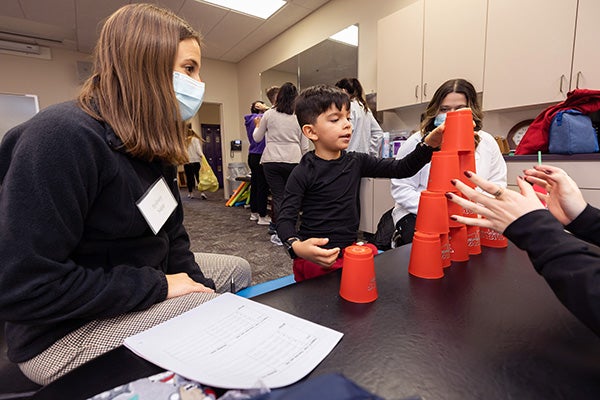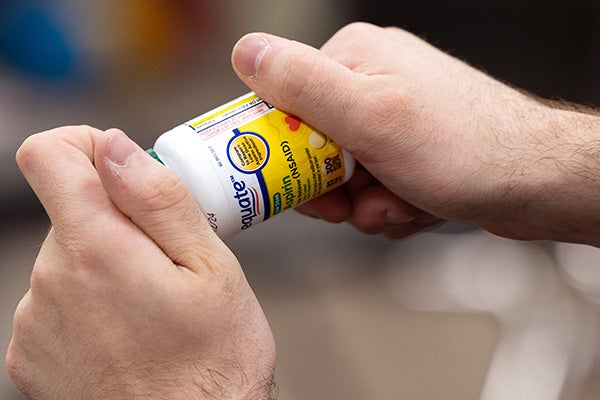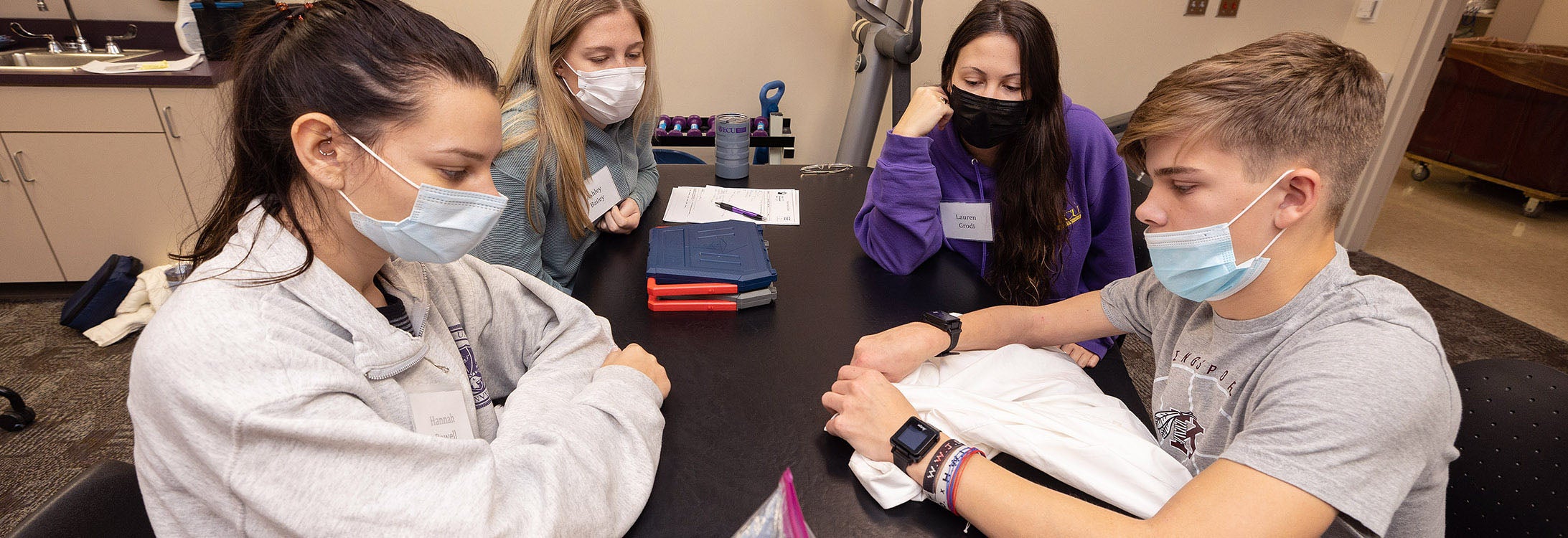ANYTHING BUT A GAME
ECU researchers work to improve limb function for kids with cerebral palsy
“I said HUT! I said HUT!”
Three young boys roughhousing an improvised game of football in an East Carolina University conference room on a cool, overcast late fall day wasn’t altogether that unusual. The fact that they all had some form of cerebral palsy and that their teammates were all college students, was.
In an adjoining room, a pre-school-aged girl — face framed with a zoo of curls — was busy tricking her own contingent of college student-minders to win a game of Connect Four. Her trouble wasn’t conning her opponent into winning, but getting her tiny fingers to slip the game piece into a narrow slot at the top of the game board.
She too has cerebral palsy and the coin-sized piece of plastic was devilish.
Children’s games? Maybe for the uninitiated observer. But for ECU’s Swati Surkar and a platoon of college students volunteering after the end of the fall semester, studying children with function-limiting brain damage — getting them to use hands and arms in ways that their bodies normally refuse — was anything but a game.
The study
Last year Surkar, an assistant professor of physical therapy at the College of Allied Health Sciences, began a pilot program to study the potential for improvements for children and young adults who deal with brain injuries.
The Hand-Arm Bimanual Intensive Therapy, or HABIT, program is offered to patients who have had disruption of their brain’s connection with half of their body. They were given fun, but often quite challenging, physical tasks that must be completed with both arms and hands, not just their stronger one.
Patients in the study are generally affected by cerebral palsy affecting one side of the body. Cerebral palsy results when the brain is somehow damaged, usually before birth or shortly thereafter, which limits muscle control, disrupts balance and affects posture.
As part of the study, Surkar has included ischemia — restricting blood flow to the affected limb with a blood pressure cuff for five-minute increments over about 45 minutes — into the therapy sessions. Using a blood pressure cuff allows researchers to be very specific in how much pressure is applied to the patient’s arm, for the sake of safety and to ensure that patients in the control and test groups aren’t aware which category they are in as they all receive some measure of pressure.
“We have completed two clinical trials now so the safety and efficacy is established,” Surkar said. “This is a safe intervention.”
In addition to restricting blood flow to the arm, patients in the study have regions of their brain mapped with computers and wear smart watch-sized monitors on each arm during the study to track movement. The monitors allow the researchers to track how much the kids use their non-dominant arm during therapeutic activities like stacking plastic cups and stringing a fishing pole with fishing line.
Surkar’s study is now fully funded by the National Institutes of Health and in a triple blind phase where neither she as the lead researcher, the patients nor the study assessors know which patient received the intervention.
During her postdoctoral fellowship, Surkar did a similar study in older adults, most who had suffered strokes. That study showed promising results in terms of enhanced strength in limbs affected by stroke-induced damage and improved balance. Surkar’s long-term research interests lie in children with CP, and the promise shown by the results from the study of elderly stroke patients lead her to believe that similar gains could be made by children.
The patients
The children participating in the study, from those just reaching school age to teens in high school, came from as far as northern Virginia and even Mexico to participate in the camp. Regardless of their hometowns, or even their first languages, what tied them together was partial paralysis of one arm due to a brain injury and the motivation to do the work necessary to improve their situation.
“The kids think they’re playing all day,” said Casey Burroughs, a third-year student in ECU’s Doctor of Physical Therapy program. “But for us, behind the scenes, we’re thinking about every game that they’re playing as purposeful movements to help them use both their hands together. It’s neat to see that the kids get to play together, with each other. They really enjoy that but for we volunteers working with them, there is a purpose to the play.”

A study participant is tested by stacking plastic cups as HABIT study volunteers evaluate his efforts.
Burroughs said that the study camp has immediate benefits because children with cerebral palsy, who likely don’t have anyone else in their communities who look and move like them, can see that they aren’t alone.
“We have a girl who has a YouTube channel where she shows how she does her hair with cerebral palsy,” Burroughs said. “Yesterday, when she got together with another girl her age, they were able to do their hair together and be able to put it up in a ponytail, which sounds like a little thing but to them that’s a great joy — to be able to do for themselves.”
The YouTuber in the study, Reagan Bischoff, was having 60 seizures a day and taking a host of anti-seizure medications by the time she was 2 months old. Brain surgery temporarily ended the seizures but left Reagan with partial paralysis in her left leg and arm. A button buttoning arm. A lacrosse playing arm. A trumpet playing arm. The seizures ultimately returned, but they are controllable now, which her mother Danielle considers a blessing.
The ECU HABIT study is a world apart from the treatment that Reagan received in the past, Danielle Bischoff said. Reagan, with her mother at her side, has been through rounds of treatment and rehabilitation at world-class programs nearer to their home in Virginia, but the hands-on, tailored approach that Surkar and her team have taken made the experience at ECU beneficial.
“My daughter was not excited about going to therapy. It’s her vacation. We were up at 7:30 in the morning — she’s a teenager she wants to sleep in and be on TikTok,” Bischoff said.
Surkar and her team evaluated each study participant and paired them with a lead study volunteer, generally a health science-oriented ECU student, whose personality suited each child.
“Reagan was paired with a therapy student who was engaging and started pulling things out of her like, ‘Oh, you like soccer, too? Oh, the World Cup is today,’” Bischoff recounted, suggesting the program wouldn’t have been as successful without that. “We’ve participated in programs that are not as structured or as organized. The ECU volunteers are on time, they follow a schedule — they want to be here, and they want to do activities that interest each participant.”
“All therapy is also play-based and involved other kids, which makes it fun,” Bischoff continued. “These details make all the difference in the world when you’re asking a child to spend five days in therapy. It says a lot that Reagan asked if she could come back and do it again.”
The promise
While the results from this year’s study will take time to shake out, Surkar and her team of volunteers are already seeing promising preliminary results from the previous year’s study. Of 12 participants, the seven students in the experimental group — the ones who received the ischemic conditioning — saw improvements in hand function and brain plasticity, meaning the brain was able to make new connections that increase limb functionality.
In short, the kids in the first study got better.

A HABIT study volunteer demonstrates to study participants how to open a medicine bottle, a difficult task for those with cerebral palsy.
Surkar hopes the ischemic conditioning model will be proven effective.
“If this intervention works, it will be very clinically feasible because families can do it at home,” Surkar said. “It will be probably more cost effective. That’s the future hope, if the hypotheses are supported.”
But while the studies show that damaged nervous systems can be improved in individuals with cerebral palsy, simply having a “HABIT camp” where kids can interact with others like them and experience not might be just as powerful.
Burroughs will graduate in May and has been working with Surkar’s team for two years. The Wake Forest native is using the research experience from the HABIT study as her capstone project to complete her degree.
“Seeing a participant out in the grocery store without their walker; seeing them go from having to use it to not having to has been really rewarding to see,” Burroughs said.
Everyone involved in the study is wide-eyed about the long-term realities of the therapy: maintaining the gains made during a hyper-intensive, multi-day program where each patient is doted on by three or four volunteers is quite different than being at home, where self-motivation can lead success slippage.
“When you look at the statistical data of from the watches, it is factual that when she is here, and she is in that therapy, she’s using her left hand more,” Bischoff said, noting that Reagan sees the benefit of putting in the work as she has gotten older. “Getting her to recognize that value is so powerful. She’s able to understand what she’s being asked to do and see the benefits in a different way now that she’s older.”
Surkar is equally hopeful and expectant that the children in her study will find success.
“This is the first study in children with cerebral palsy, investigating the effects of this particular intervention,” she said. “It’s a novel concept, and we are really looking forward to seeing how the data looks.”
